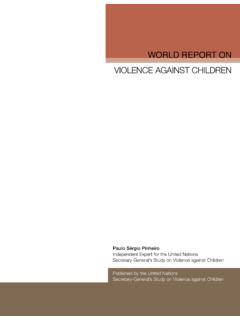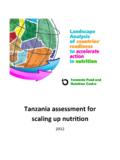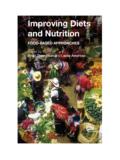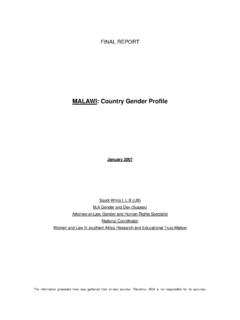Transcription of NutritioN at a TANZANIA - World Bank
1 TANZANIAN utritioNGLANCEat aTechnical Notes Stunting is low height for age. underweight is low weight for age. Wasting is low weight for height. Current stunting, underweight, and wasting estimates are based on comparison of the most recent survey data with the WHO Child Growth Standards, released in 2006. They are not directly comparable to the trend data shown in Figure 1, which are calculated according to the previously-used NCHS/WHO reference population. Low birth weight is a birth weight less than methodology for calculating nationwide costs of vitamin and mineral deficiencies, and interventions included in the cost of scaling up, can be found at: up core micronutrient interventions would cost TANZANIA less than US$26 million per year.
2 (See Technical Notes for more information)Key Actions to Address Malnutrition:Increase NutritioN capacity within the Ministries of Health and infant and young child feeding through effective education and counseling actions to reduce anemia through increased deworming of young children, and iron-folic acid supplementation for pregnant dietary diversity through promoting home production of a diversity of foods, and market and infrastructure universal salt iodization, and enrichment of oil and staple foods with key Context HDi ranking: 151st out of 182 countries1 Life expectancy: 56 years2 Lifetime risk of maternal death: 1 in 242under-five mortality rate: 116 per 1,000 live births2 Global ranking of stunting prevalence: 19th-highest out of 136 countries2 The Costs of Undernutrition Over one-third of child deaths are due to undernu-trition, mostly from increased severity of Children who are undernourished between con-ception and age two are at high risk for impaired cognitive development, which adversely affects the country s productivity and growth.
3 The economic costs of undernutrition include direct costs such as the increased burden on the health care system, and indirect costs of lost pro-ductivity. Every year deficiencies in iron, vitamin A and fo-lic acid alone cost TANZANIA over US$ 518 million, around % of the country s Childhood anemia alone is associated with a drop in adult Does TANZANIA Stand? 44% of children under the age of five are stunted, 17% are underweight, and 4% are 1 in 10 infants are born with a low birth TANZANIA has achieved high rates of vitamin A supplementation: 93% of children 6 59 months of age receive the recommended two doses of vi-tamin A approximately six month seen in Figure 2, TANZANIA has higher rates of stunting than most of its income peers in the region.
4 Mineral Deficiencies Cause Hidden HungerAlthough they may not be visible to the naked ye, vitamin and mineral deficiencies impact well-being and are prevalent in TANZANIA , as indicated in Figure 3. Adequate intake of micronutrients, particularly iron, vitamin A, iodine and zinc, from concep-tion to age 24 months is critical for child growth and mental 2 TANZANIA has Comparable rates of Stunting to its Neighbors but Higher rates than its income PeersGNI per capita (US$2008)Prevalence of Stunting AmongChildren Under 5 (%) 0100200300400500600700800900100001020304 05060 TanzaniaGambiaDR CongoMalawiMozambiqueUgandaZambiaGuineaK enyaSource: Stunting rates were obtained from the WHO Global Database on Child Growth and Malnutrition (figures based on WHO child growth standards).
5 GNI data were obtained from the World Bank s World Development 1 TANZANIA s Progress toward MDG 1 is insufficientPrevalence Among ChildrenUnder 5 (%)StuntingUnderweight2015 MDG Underweight Target1991/92199619992004/05051015202530 35404550 Source: WHO Global Database on Child Growth and Malnutrition (figures based on the NCHS/WHO reference population).Most of the irreversible damage due to malnutrition happens during gestation and in the first 24 months of : Anna shown in Figure 1, although the overall preva-lence of stunting and underweight has been decreasing over the past two decades TANZANIA will not meet MDG 1c (halving 1990 rates of child underweight by 2015) with business as World BANKP roduced with support from the Japan trust Fund for Scaling up NutritionTANZANIAS olutions to Primary Causes of UndernutritionPoor infant Feeding Practices 59% of infants under six months are not exclu-sively During the important transition period to a mix of breast milk and solid foods between six and nine months of age, more than one-half of infants are not fed appropriately with both breast milk and other.
6 Support women and their families to practice optimal breastfeeding and ensure timely and adequate complementary feeding. Breast milk fulfills all nutritional needs of infants up to six months of age, boosts their immunity, and reduces exposure to infections. In high HIV settings, follow WHO 2009 HIV and infant feeding revised principles and Disease Burden 15% of deaths of children under 5 are due to pneu-monia, and 12% are due to Undernutrition increases the likelihood of falling sick and severity of disease. Undernourished children who fall sick are much more likely to die from illness than well-nourished children. Parasitic infestation diverts nutrients from the body and can cause blood loss and : Prevent and treat childhood infection and other disease.
7 Hand-washing, deworming, zinc sup-plements during and after diarrhea, and continued feeding during illness are Access to Nutritious Food Achieving food security means ensuring quality and continuity of food access, in addition to quantity, for all household members. 71% of energy comes from staple High rates of hidden hunger in TANZANIA result from low dietary diversity. In addition to improved access to diverse diets, food fortification can help address micronutrient : Involve multiple sectors including agricul-ture, education, transport, gender, the food industry, environment, health and other sectors, to ensure that diverse, nutritious diets are available and accessible to all household members. Vitamin A: 24% of preschool aged children and 15% of pregnant women are deficient in vita-min Supplementation of young children and dietary diversification can eliminate this defi-ciency.
8 Iron: Current rates of anemia among preschool aged children and pregnant women are 72% and 58%, Iron-folic acid supplementation of pregnant women, deworming, provision of mul-tiple micronutrient supplements to infants and young children, and fortification of staple foods are effective strategies to improve the iron status of these vulner-able subgroups. Iodine: Less than one-half of households con-sume iodized salt, leaving over 1 million infants remain unprotected from iodine deficiency Bank NutritioN -Related Activities in TanzaniaProjects: Through additional financing to the health sector, a Japan Social Development Fund project and the Scaling-Up NutritioN initiative, The World Bank is committed to support the acceleration of food for-tification in TANZANIA , following an economic and sector work report on NutritioN in 2008.
9 A recent report has estimated that $1 invested in food fortification in TANZANIA can result in an eco-nomic return of US$ or an increase in GDP of In addition, almost 6,800 deaths per year would be The World Bank approved US$40 million in additional financing for the second phase of TANZANIA s Health Sector Development Project. Of this, US$2 million has specifically been directed towards developing and implementing a national food fortification program, including sustainable approaches to food fortification in rural areas. Analytic Work: Several health-related reports and policy notes have been produced in the past years including a detailed NutritioN study in 200711 and the national food fortification action plan in UNDP.
10 2009. Human Development Report. 2. UNICEF. 2009. State of the World s Vester et al. 2010. Action Plan for the Provision of Vitamins and Minerals to the Tanzanian Population through the Enrichment of Staple Foods. World Horton S and Ross J. 2003. The Economics of Iron Deficiency. Food Policy 28 UNICEF. 2009. Tracking Progress on Child and Maternal NutritioN . 6. WHO. 2009. HIV and infant feeding: Revised principles and recommendations Rapid TANZANIA Bureau of Statistics. 2007. TANZANIA Household Budget WHO. 2008. Worldwide Prevalence of Anemia 1993 2005: WHO Global Database on Anemia. 9. WHO. 2009. Global Prevalence of Vitamin A Deficiency in Populations at Risk 1995 2005. WHO Global Database on Vitamin A Deficiency.
















